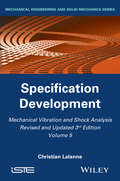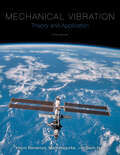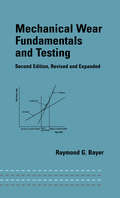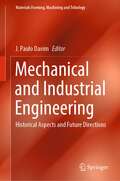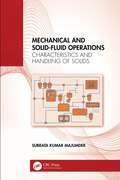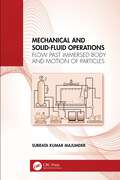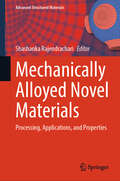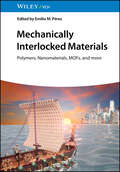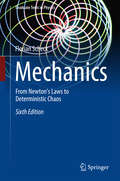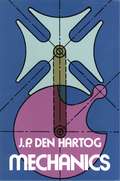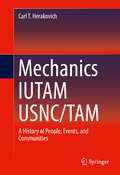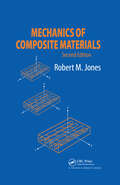- Table View
- List View
Mechanical Vibration and Shock Analysis, Random Vibration: Random Vibration (Iste Ser. #404)
by Christian LalanneThe vast majority of vibrations encountered in the real environment are random in nature. Such vibrations are intrinsically complicated and this volume describes the process that enables us to simplify the required analysis, along with the analysis of the signal in the frequency domain. The power spectrum density is also defined, together with the requisite precautions to be taken in its calculations as well as the processes (windowing, overlapping) necessary to obtain improved results. An additional complementary method – the analysis of statistical properties of the time signal – is also described. This enables the distribution law of the maxima of a random Gaussian signal to be determined and simplifies the calculation of fatigue damage by avoiding direct peak counting.
Mechanical Vibration and Shock Analysis, Sinusoidal Vibration: Sinusoidal Vibration (Iste Ser. #402)
by Christian LalanneEverything engineers need to know about mechanical vibration and shock...in one authoritative reference work! This fully updated and revised 3rd edition addresses the entire field of mechanical vibration and shock as one of the most important types of load and stress applied to structures, machines and components in the real world. Examples include everything from the regular and predictable loads applied to turbines, motors or helicopters by the spinning of their constituent parts to the ability of buildings to withstand damage from wind loads or explosions, and the need for cars to maintain structural integrity in the event of a crash. There are detailed examinations of underlying theory, models developed for specific applications, performance of materials under test conditions and in real-world settings, and case studies and discussions of how the relationships between these affect design for actual products. Invaluable to engineers specializing in mechanical, aeronautical, civil, electrical and transportation engineering, this reference work, in five volumes is a crucial resource for the solution of shock and vibration problems. The relative and absolute response of a mechanical system with a single degree of freedom is considered for an arbitrary excitation, and its transfer function is defined in various forms. The characteristics of sinusoidal vibration are examined in the context both of the real world and of laboratory tests, and for both transient and steady state response of the one-degree-of-freedom system. Viscous damping and then non-linear damping are considered. The various types of swept sine perturbations and their properties are described and, for the one-degree-of-freedom system, the consequence of an inappropriate choice of sweep rate are considered. From the latter, rules governing the choice of suitable sweep rates are then developed.
Mechanical Vibration and Shock Analysis, Specification Development: Specification Development (Iste Ser.)
by Christian LalanneEverything engineers need to know about mechanical vibration and shock...in one authoritative reference work! This fully updated and revised 3rd edition addresses the entire field of mechanical vibration and shock as one of the most important types of load and stress applied to structures, machines and components in the real world. Examples include everything from the regular and predictable loads applied to turbines, motors or helicopters by the spinning of their constituent parts to the ability of buildings to withstand damage from wind loads or explosions, and the need for cars to maintain structural integrity in the event of a crash. There are detailed examinations of underlying theory, models developed for specific applications, performance of materials under test conditions and in real-world settings, and case studies and discussions of how the relationships between these affect design for actual products. Invaluable to engineers specializing in mechanical, aeronautical, civil, electrical and transportation engineering, this reference work, in five volumes is a crucial resource for the solution of shock and vibration problems. This volume focuses on specification development in accordance with the principle of tailoring. Extreme response and the fatigue damage spectra are defined for each type of stress (sinusoidal vibration, swept sine, shock, random vibration, etc.). The process for establishing a specification from the life cycle profile of equipment which will be subject to these types of stresses is then detailed. The analysis takes into account the uncertainty factor, designed to cover uncertainties related to the real-world environment and mechanical strength, and the test factor, which takes account of the number of tests performed to demonstrate the resistance of the equipment.
Mechanical Vibration: Theory and Application
by Haym Benaroya Mark Nagurka Seon Mi HanThe Fifth edition of this classic textbook includes a solutions manual. Extensive supplemental instructor resources are forthcoming in the Fall of 2022. Mechanical Vibration: Theory and Application presents comprehensive coverage of the fundamental principles of mechanical vibration, including the theory of vibration, as well as discussions and examples of the applications of these principles to practical engineering problems. The book also addresses the effects of uncertainties in vibration analysis and design and develops passive and active methods for the control of vibration. Many example problems with solutions are provided. These examples as well as compelling case studies and stories of real-world applications of mechanical vibration have been carefully chosen and presented to help the reader gain a thorough understanding of the subject. There is a solutions manual for instructors who adopt this book. Request a solutions manual here (https://www.rutgersuniversitypress.org/mechanical-vibration).
Mechanical Vibrations
by Daniel J. Rixen Michel GeradinMechanical Vibrations: Theory and Application to Structural Dynamics, Third Edition is a comprehensively updated new edition of the popular textbook. It presents the theory of vibrations in the context of structural analysis and covers applications in mechanical and aerospace engineering. Although keeping the same overall structure, the content of this new edition has been significantly revised in order to cover new topics, enhance focus on selected important issues, provide sets of exercises and improve the quality of presentation.Without being exhaustive (see the Introduction for a comprehensive list), some key features include: A systematic approach to dynamic reduction and substructuring, based on duality between mechanical and admittance conceptsAn introduction to experimental modal analysis and identification methodsAn improved, more physical presentation of wave propagation phenomenaA comprehensive presentation of current practice for solving large eigenproblems, focusing on the efficient linear solution of large, sparse and possibly singular systemsA deeply revised description of time integration schemes, providing framework for the rigorous accuracy/stability analysis of now widely used algorithms such as HHT and Generalized-αSolved exercises and end of chapter homework problemsA companion website hosting supplementary materialWith revised, coherent and uniform notation, Mechanical Vibrations: Theory and Application to Structural Dynamics, Third Edition is a must-have textbook for graduate students working with vibration in mechanical, aerospace and civil engineering, and is also an excellent reference for researchers and industry practitioners.
Mechanical Vibrations
by K. Scott Smith Tony L. SchmitzMechanical Vibrations: Modeling and Measurement describes essential concepts in vibration analysis of mechanical systems. It incorporates the required mathematics, experimental techniques, fundamentals of model analysis, and beam theory into a unified framework that is written to be accessible to undergraduate students, researchers, and practicing engineers. To unify the various concepts, a single experimental platform is used throughout the text. Engineering drawings for the platform are included in an appendix. Additionally, MATLAB programming solutions are integrated into the content throughout the text.
Mechanical Vibrations: Applications to Equipment
by Yvon MoriThe purpose of this book is to clarify the issues related to the environment of mechanical vibrations in the material life profile. In particular, through their simulation testing laboratory, through a better understanding of the physical phenomenon, means to implement to simulate, measurements and interpretations associated results. It is aimed at development of technical consultants, quality and services primarily to those testing laboratories, as well as to all those who are faced with supply reference to the environmental test calls and particularly here, vibration tests. Furthermore it should also interest students of engineering schools in the areas of competence of their future professions affected by vibration. We thus define the phenomenon of vibrations from the standpoint of environmental specialist through some basic concepts essential to know how to interpret the normative documents published to date and perform some simple calculations of predictive behavior of the studied material.
Mechanical Vibrations: Modeling and Measurement
by K. Scott Smith Tony L. SchmitzNow in an updated second edition, this classroom-tested textbook describes essential concepts in vibration analysis of mechanical systems.The second edition includes a new chapter on finite element modeling and an updated section on dynamic vibration absorbers, as well as new student exercises in each chapter. It incorporates the required mathematics, experimental techniques, fundamentals of modal analysis, and beam theory into a unified framework that is written to be accessible to undergraduate students, researchers, and practicing engineers. To unify the various concepts, a single experimental platform is used throughout the text to provide experimental data and evaluation. Engineering drawings for the platform are included in an appendix. Additionally, MATLAB programming solutions are integrated into the content throughout the text.The book is ideal for undergraduate students, researchers, and practicing engineers who are interested in developing a more thorough understanding of essential concepts in vibration analysis of mechanical systems.Presents a clear connection between continuous beam models and finite degree of freedom models;Includes MATLAB code to support numerical examples that are integrated into the text narrative;Uses mathematics to support vibrations theory and emphasizes the practical significance of the results.
Mechanical Wear Fundamentals and Testing, Revised and Expanded
by Raymond J. BayerWritten by a tribological expert with more than thirty years of experience in the field, Mechanical Wear Fundamentals and Testing, Second Edition compiles an extensive range of graphs, tables, micrographs, and drawings to illustrate wear, friction, and lubrication behavior in modern engineering applications. The author promotes a clear understandin
Mechanical and Chemical Signaling in Angiogenesis
by Cynthia A. Reinhart-KingThis volume describes and discusses recent advances in angiogenesis research. The chapters are organized to address all biological length scales of angiogenesis: molecular, cellular and tissue in both in vivo and in vitro settings. Specific emphasis is given to novel methodologies and biomaterials that have been developed and applied to angiogenesis research. Angiogenesis experts from diverse fields including engineering, cell and developmental biology, chemistry and physics will be invited to contribute chapters which focus on the mechanical and chemical signals which affect and promote angiogenesis.
Mechanical and Electrical Systems in Buildings
by Richard R. Janis William K. Y. TaoThis extensively updated text and reference illuminates the modern realities of planning and constructing buildings with efficient, sustainable mechanical and electrical systems. Throughout, the authors place mechanical and electrical systems design in the overall context of the built environment. They extensively address engineers' teamwork with architects, owners, and facility managers to provide high-quality, productive environments which reflect both environmental and cost concerns. Focusing on the "what," "why," and "how" of ME systems, they incorporate new developments in all major disciplines, including electrical, lighting, telecom, plumbing and HVAC. New coverage in this edition includes: HVAC design using VRF and chilled beam technologies; energy reclaim systems; dedicated outside air systems; assessment of solar thermal system efficiency; new fuel cell technology; updates on the economics of cogeneration, and much more.
Mechanical and Electromagnetic Vibrations and Waves
by Tamer BécherrawyDealing with vibrations and waves, this text aims to provide understanding of the basic principles and methods of analysing various physical phenomena. The content includes the general properties of propagation, a detailed study of mechanical (elastic and acoustic) and electromagnetic waves, propagation, attenuation, dispersion, reflection, interference and diffraction of waves. It features chapters on the effect of motion of sources and observers (both classical and relativistic), emission of electromagnetic waves, standing and guided waves and a final chapter on de Broglie waves constitutes an introduction to quantum mechanics.
Mechanical and Industrial Engineering: Historical Aspects and Future Directions (Materials Forming, Machining and Tribology)
by J. Paulo DavimThis book covers historical aspects and future directions of mechanical and industrial engineering. Chapters of this book include applied mechanics and design, tribology, machining, additive manufacturing and management of industrial technologies.
Mechanical and Solid-Fluid Operations: Characteristics and Handling of Solids
by Subrata Kumar MajumderThe text comprehensively discusses the transport mechanism, storage, and conveying of the material, which are essential requirements for transporting solids in various process units, especially in mineral and chemical industries. It covers the properties of particles and particulate systems and focuses on their characterization and analysis.This book: Presents a discussion of theoretical principles coupled with illustrative examples to help readers learn how to operate, optimize, and innovate particle processing technologies Covers transport characterization of the solid-fluid operations, slurry physical properties, and properties of particles Illustrates systematic and comprehensive understanding of fundamental phenomena of properties of particles and handling of particulate systems Explains graphical representation of particle size, particle size measurement, and particle size distribution Includes ancillary material such as numerical problems, review questions, multiple choice questions, and exercises at the end of each chapter It is primarily written for senior undergraduates, graduate students, and academic researchers in fields including chemical engineering, mechanical engineering, environmental engineering, industrial engineering, manufacturing engineering, and chemistry.
Mechanical and Solid-Fluid Operations: Flow Past Immersed Body and Motion of Particles
by Subrata Kumar MajumderThe text thoroughly discusses the fundamentals of flow resistance over a solid body, the frictional resistance of flow through a granular bed, and the flow phenomena of particles, which are essential requirements for solid-fluid operations in various process units, especially in mineral and chemical industries. It elucidates the fundamentals of drag force on a solid, terminal velocity of the particle, sedimentation, slurry mixing, fluidization phenomena and froth flotation.This book: Presents a discussion of theoretical principles and illustrative examples to help readers learn how to operate, optimize, and innovate particle processing technologies Covers the fundamentals of drag force on a solid, terminal velocity of the particle, and sedimentation (hindered settling) Explain the basic law and terminology of fluid flow through a granular bed, mixing characteristics in an agitator, and its standard design Illustrates systematic and comprehensive understandings of the fundamental phenomena of fluidization and the basic principles and kinetics of froth flotation Includes ancillary material such as numerical problems, review questions, multiple choice questions, and exercises at the end of each chapter It is primarily written for senior undergraduates, graduate students, and academic researchers in chemical engineering, mechanical engineering, environmental engineering, industrial engineering, manufacturing engineering, and chemistry.
Mechanical and Solid-Fluid Operations: Separation of Particulate Materials
by Subrata Kumar MajumderThe text presents fundamental principles and analysis of the separation of particulate matter. Analysis and reduction of air pollution involve a variety of technical disciplines. The effective way to control air pollution is to prevent the release of pollutants at the source. The treatment can involve intimately contacting the effluent gases with liquids or solids capable of selectively removing gaseous pollutants or, in the case of particulate contaminants, directing the effluent flow through a device in which the particles are captured on surfaces.This book: Introduces the principle of separation methods of particulate matter (PM), common control equipment of PM, and collection or removal efficiency of the equipment Describes the concept of separation of particles by sieving/screening, the basic principles of screening equipment, and the screen's effectiveness Present the fundamental theories of removing particulate and gaseous pollutants from effluent streams by pollution control operations, such as gravitational (gravity chambers) and centrifugal deposition (cyclone separator), electrostatic precipitation, filtration, and wet scrubbing and covers fundamental principles of membrane separation, membrane modules, process design, applications, and governing equations of plate and frame filter press and rotary drum filter Deals with the basic understanding of reverse osmosis and its theoretical analysis by different total flux and capacity models and explains the basic understanding of adsorption onto the solid surface and their isotherm and kinetics Includes ancillary material such as numerical problems, review questions, multiple choice questions, and exercises at the end of each chapter It is primarily written for senior undergraduates, graduate students, and academic researchers in chemical engineering, mechanical engineering, environmental engineering, industrial engineering, manufacturing engineering, and chemistry.
Mechanical and Thermal Measurements by Images and Waves: Principles and Applications (Smart Sensors, Measurement and Instrumentation #51)
by Gianluca RossiThis book provides a comprehensive overview of the principles underlying mechanical and electromagnetic fields and waves, followed by an introduction to the fundamental theories of analog and digital image acquisition and processing. It explores advanced techniques for measuring velocity, deformation, stress, temperature, pressure, and object shapes using image analysis and beam scanning methods. Topics include optical scanners for shape measurement, optical flow, Particle Image Velocimetry (PIV), Digital Image Correlation (DIC), infrared thermography, Thermoelastic Stress Analysis (TSA), Laser Doppler Vibrometry (LDV), Laser Doppler Anemometry (LDA), ultrasonic scanning (SONAR and echography), radio wave scanning (RADAR), and Industrial Computed Tomography (ICT), along with key wave- and image-based methods for pressure field measurements. Drawing on nearly thirty years of the authors&’ experience, gained through numerous research projects and collaborations with leading industries, the book presents numerous applications in non-destructive diagnostics, quality control, reverse engineering, and experimental mechanics in mechanical, civil engineering and in many other fields. It is intended to serve as both an introduction and a comprehensive reference for professors, researchers, and professionals looking to understand, evaluate, teach and effectively apply wave- and image-based measurement techniques.
Mechanically Alloyed Novel Materials: Processing, Applications, and Properties (Advanced Structured Materials #220)
by Shashanka RajendrachariThis book provides in-depth information about the evolution of mechanical alloying over the past few decades. It explains how the technology has improved with time and the different types of mechanical alloying processes and their mechanisms to prepare powders. It presents factors affecting the mechanical alloying process followed by an overview and comparison of dry and wet milling. A comparative study of mechanical alloying and other conventional powder metallurgical methods to achieve maximum density for structure-property relationship is also presented. The book also provides information about modern methods used to characterize the ball milled powders and their consolidation by highly advanced sintering methods. It discusses the processing, properties, and applications of high entropy alloys, ODS stainless steel, shape memory alloys, cermets, iron, copper, zinc, tungsten, aluminum, titanium, magnesium, and ceramic-based alloys. Apart from these topics, the book covers important types of ferrous and non-ferrous alloys that are prepared by mechanical alloying, providing an insight as to why this method is popular and advantageous over other conventional powder metallurgical methods, and discussing the appropriate method for fabricating each type of ferrous and non-ferrous alloys.
Mechanically Gated Channels and their Regulation
by Andre Kamkin Ilya LozinskyThe volume dwells on the major issues of mechanical stress influencing the ion channels and intracellular signaling pathways. This book is a unique collection of reviews outlining current knowledge and future developments in this rapidly growing field. In our opinion the book presents not only the latest achievements in the field but also brings the problem closer to the experts in related medical and biological sciences as well as practicing doctors. Knowledge of the mechanisms which underlie these processes is necessary for understanding of the normal functioning of different living organs and tissues and allows to predict changes, which arise due to alterations of their environment, and possibly will allow to develop new methods of artificial intervention. We also hope that presenting the problem will attract more attention to it both from researchers and practitioners and will assist to efficiently introduce it into the practical medicine.
Mechanically Interlocked Materials: Polymers, Nanomaterials, MOFs, and more
by Emilio M. PérezMechanically Interlocked Materials Comprehensive one-stop resource on the emerging world of mechanically interlocked materials (MIMats) Mechanically Interlocked Materials provides a thorough overview of the new emerging field in supramolecular chemistry. Edited by one of the leading researchers in the field, Mechanically Interlocked Materials includes information on: Types of MIMats, such as metal organic frameworks, polymers, carbon nanotubes, nanoparticles, and othersMain advantages/disadvantages of the mechanical bond of MIMats with respect to covalent or supramolecular alternativesMechanically interlocked (MI) electronics, molecular materials, nano and micro particles, nucleic acids, and proteinsForce in MIMs, MIMs on surfaces, polycatenanes, sliding ring gels, and potential applications of MIMats as molecular switches and binary materials With comprehensive coverage of an important emerging field, Mechanically Interlocked Materials is an essential resource for students and professionals in a variety of scientific fields, including organic, inorganic, supramolecular, and physical chemistry, physics, materials science, and nanotechnology.
Mechanics
by Masud Chaichian Anca Tureanu Ioan MerchesMechanics is one of the oldest and at the same time newest disciplines, in the sense that there are methods and principles developed first in mechanics but now widely used in almost all branches of physics: electrodynamics, quantum mechanics, classical and quantum field theory, special and general theory of relativity, etc. More than that, there are some formalisms like Lagrangian and Hamiltonian approaches, which represent the key stone for the development of the above-mentioned disciplines. During the last 20-25 years, classical mechanics has undergone an important revival associated with the progress in non-linear dynamics, applications of Noether's theorem and the extension of variational principles in various interdisciplinary sciences (for instance, magnetofluid dynamics). Thus, there ought to exist a book concerned with the applied analytical formalism, first developed in the frame of theoretical mechanics, which has proved to be one of the most efficient tools of investigation in the entire arena of science.The present book is an outcome of the authors' teaching experience over many years in different countries and for different students studying diverse fields of physics. The book is intended for students at the level of undergraduate and graduate studies in physics, engineering, astronomy, applied mathematics and for researchers working in related subjects. We hope that the original presentation and the distribution of the topics, the various applications in many branches of physics and the set of more than 100 proposed problems, shall make this book a comprehensive and useful tool for students and researchers. The present book is an outcome of the authors' teaching experience over many years in different countries and for different students studying diverse fields of physics. The book is intended for students at the level of undergraduate and graduate studies in physics, engineering, astronomy, applied mathematics and for researchers working in related subjects. We hope that the original presentation and the distribution of the topics, the various applications in many branches of physics and the set of more than 100 proposed problems, shall make this book a comprehensive and useful tool for students and researchers.
Mechanics
by Florian ScheckPurpose and Emphasis. Mechanics not only is the oldest branch of physics but was and still is the basis for all of theoretical physics. Quantum mechanics can hardly be understood, perhaps cannot even be formulated, without a good knowledge of general mechanics. Field theories such as electrodynamics borrow their formal framework and many of their building principles from mechanics. In short, throughout the many modem developments of physics where one fre quently turns back to the principles of c1assical mechanics its model character is feIt. For this reason it is not surprising that the presentation of mechanics reflects to some extent the development of modem physics and that today this c1assical branch of theoretical physics is taught rather differently than at the time of Arnold Sommerfeld, in the 1920s, or even in the 1950s, when more emphasis was put on the theory and the applications of partial-differential equations. Today, symme tries and invariance principles, the structure ofthespace-time continuum, and the geometrical structure of mechanics play an important role. The beginner should realize that mechanics is not primarily the art of describing block-and-tackles, coIIisions of billiard balls, constrained motions of the cylinder in a washing ma chine, or bicycle riding.
Mechanics
by J. P. HartogFirst published over 40 years ago, this work has achieved the status of a classic among introductory texts on mechanics. Den Hartog is known for his lively, discursive and often witty presentations of all the fundamental material of both statics and dynamics (and considerable more advanced material) in new, original ways that provide students with insights into mechanical relationships that other books do not always succeed in conveying. On the other hand, the work is so replete with engineering applications and actual design problems that it is as valuable as a reference to the practicing engineer as it is as a text or refresher for the general engineering student. Mechanics is not a "heavy" book, despite the amount of material it covers and the clarity and exactness with which it treats this material. It is undoubtedly one of the most readable texts in the field. More than 550 drawings and diagrams in the regular text and in the highly praised 112-page section of problems and answers further contribute to its lucidity and value. The emphasis is consistently on illuminating fundamental principles and in showing how they are embodied in a high number of real engineering and design problems concerning trusses, loaded cables, beams, jacks, hoists, brakes, cantilevers, springs, balances, pendulums, projectiles, cranks, linkages, propellers, turbines, fly ball engine governors, hydraulic couplings, anti-roll devices, gyroscopes, and hundreds of other mechanical systems and devices.Chapters cover Discrete Coplanar Forces, Conditions of Equilibrium, Distributed Forces, Trusses and Cables, Beams, Friction, Space Forces, The Method of Work, Kinematics of a Point, Dynamics of a Particle, Kinematics of Plane Motion, Moments of Inertia, Dynamics of Plane Motion, Work and Energy, Impulse and Momentum, Relative Motion, and Gyroscopes. Particularly in the last two chapters, Den Hartog provides advanced material not usual in introductory texts. "Very thoroughly recommended to all those anxious to improve their real understanding of the principles of mechanics." -- Mechanical World. Index. List of equations. 334 problems, all with answers. Over 550 diagrams and drawings.
Mechanics IUTAM USNC/TAM
by Carl T. HerakovichThis book provides a detailed history of theUnited States National Committee on Theoretical and Applied Mechanics(USNC/TAM) of the US National Academies, the relationship between the USNC/TAMand IUTAM, and a review of the many mechanicians who developed the field overtime. It emphasizes the birth and growth of USNC/TAM, the birth and growth ofthe larger International Union of Theoretical and Applied Mechanics (IUTAM),and explores the work of mechanics from Aristotle to the present. Written bythe former Secretary of USNC/TAM, Dr. Carl T. Herakovich of the University ofVirginia, the book profiles luminaries of mechanics including Galileo, Newton,Bernoulli, Euler, Cauchy, Prandtl, Einstein, von Kármán, Timoshenko, and in so doingprovides insight into centuries of scientific and technologic advance.
Mechanics Of Composite Materials
by Robert M. JonesThis book balances introduction to the basic concepts of the mechanical behavior of composite materials and laminated composite structures. It covers topics from micromechanics and macromechanics to lamination theory and plate bending, buckling, and vibration, clarifying the physical significance of composite materials. In addition to the materials covered in the first edition, this book includes more theory-experiment comparisons and updated information on the design of composite materials.


